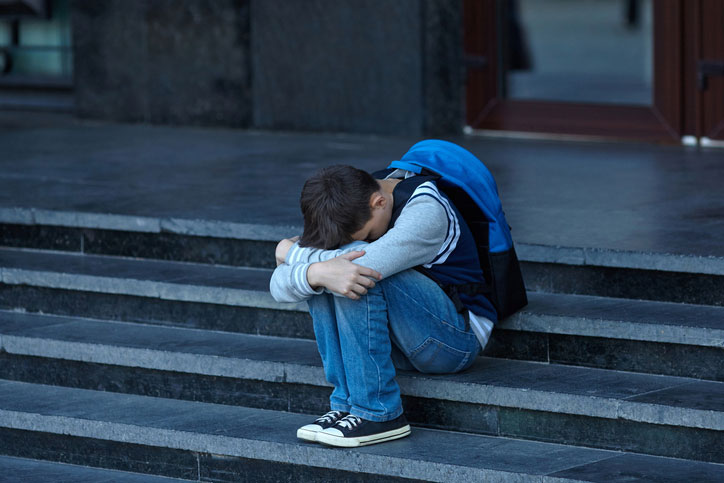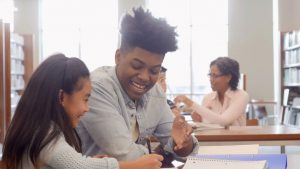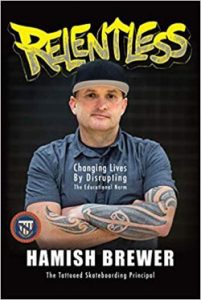9 Reasons to Give “THAT” Kid Some Extra Attention
3/5/2020

You know that one student who may drive you nuts, who may test all the boundaries, and who makes you lose sleep at night? Yes, "that" kid!
As a principal, my goal is for teachers to have tools to use with "that" kid in order to keep him or her in the classroom. I continually work with teachers on expanding these skills. Sometimes it comes down to LOVE! We can choose to dislike them or we can choose to love them.
Some teachers spend more time worrying about "that" student being in their class, rather than creating successful solutions to implement. They want this student out of their class or sent to the office for long periods of time. "That" student can cause huge disruptions in learning, especially for the remainder of the students in the classroom. I understand the student (and possibly the teacher) may need a break away from the classroom for a while.
When a teacher comes to me with a student problem, I will always support them. I am going to ask some questions first. My first question is usually about the relationship between the student and the teacher. I am going to ask what they are doing to create a stronger relationship…every day!
I am lucky at my school that my teachers have heard this mantra, some of them for nine years. Many times they come to me with solutions, strategies, ideas, and techniques rather than just bringing me the problem. You know your staff has built something strong and is healthy when you can all get to a solution fast and not wallow in the problems.
Many times we find "that" student's behaviors actually stem from a much larger issue…trauma, anxiety, or possibly more. We must see the bigger picture and understand a stronger relationship will endure the toughest times. Here are nine reasons to love "that" kid!

1 - All Behavior is a Form of Communication
Too many times we as educators do not take time to really study the behavior…dig deeper. If we dig deeper we can learn so much more about the behavior being exhibited by our students.
Time usually is a factor in truly being able to solve behavior problems. If we could find something that works immediately, we are truly lucky. As educators, we are seeing more behaviors where the strategies and techniques we once used are not working consistently.
Behavior lets us know that a student is missing something. My perspective on behavior was flipped when I took several workshops and became friends with Stacy York Nation, founder of Gobeyou.org! She illustrated that a student may need something that they never received in their young development, even sitting and consoling a high school aged student may change "that" kid's world! She talks extensively about brain development and how we can implement tools and strategies depending on the needs of each individual child.
Stacy helped me understand I need to study the behavior more. By looking at the frequency, duration, and intensity, I can find and implement strategies and solutions to difficult student behaviors. Currently, in our school we are transitioning from being trauma-informed educators to developing a trauma-invested school and community culture.
2 - Double Scoop
When a student feels safe with you, they may treat you horribly. In fact, it may even mystify you that this student is treating you this way, the "Double Scoop." First coined by Denny McLaughlin from his work in Trust Psychology, this phenomenon is true when a student lashes out against the very own care givers that are closest to the student.
As an educator we cannot take this as a personal attack against us, but understand it is a way to express frustration. We must learn to support that student. The student may hold it all in, but may feel safe enough to show you and even let it all out in your presence…sometimes towards you.
Flipping your perspective with "that" kid is vital. This is where tip #1 above is crucial. We must dig deeper into this behavior and learn not only what the triggers are, but find out what they are missing in order to process and problem solve their frustration.

3 - Be the One
It is sad to think that some students can go through their school experience and never have an advocate, not one teacher or staff member that knows them! How sad is that?
Be the one that changes "that" kid's life!
As my good friend, Hal Bowman states, "Don't give up!" … Much of his writing, meme's, and messages focus on school culture and working with the most difficult students. He professes the unwavering need for educators to have perseverance, and not giving up on "that" kid…giving them everything you have!
Twenty years down the road "that" kid will remember who fought for them, who helped them when the going was tough, and who was there for them when they needed a shoulder to cry on.
As an educator, I can tell you a few educators in my own school experience that and fit this description. Many years after graduating, I have found out that those teachers were also supporting many other students in my school. I truly put these teachers on a pedestal!
Be the one!
4 - Grow
As an educator, we sometimes feel like we cannot connect with our most challenging students. We feel like all our strategies and tools in our proverbial toolbox are not working…and we need more!
Researching best practices, connecting with colleagues in behavior and relationship building, and watching others can all be great strategies in continuing to build that toolbox. I am a firm believer if it isn't working, then I need to find something else, and not be afraid to admit it isn't working…YET!
Having a growth mindset when working with "that" kid is a must! In fact, we must continue to grow not only the toolbox, but the relationship with "that" kid. How many seeds are we planting and how much water are we giving those seeds? Sometimes it's about stepping back and deciding that maybe the seeds (problems) need fertilizer (creative ideas) instead of more water (same old strategies)!
Be open to growing yourself more and understand "that" kid is helping you grow…though it may feel like he or she is turning your hair grey or causing wrinkles!

5 - Challenge
As educators we understand that we chose this profession because we love kids. If you got into teaching for any other reason, I can predict your career will be short!
We love connecting with our kids and seeing them engage in learning experiences we create. We are challenged each day to keep that engagement at a high level. In much the same manner, we must flip our perspective on behavior.
Too many times we say, "If only I could just teach." Well, working with behaviors and engagement is teaching. Though our job description seems to change and evolve at light speed, we must flip our perspective and know that teaching behaviors IS our job!
I understand that the challenge we have with "that" kid is real. No one is saying your job is easy as an educator, but choosing education as a profession is full of challenges. We must take on these challenges the same we we take on the challenge of teaching multiplication. There are multiple ways to teach it, and we must know them all in order to connect with all our students. Likewise, we must take on the challenge to find the strategies to work with "that" kid in order to make him or her successful.
The challenge should drive us!
6 - Model for Others
Loving the toughest kid in school takes grit. Have you heard conversations in your school similar to this, "Well, Jimmy ("that" kid) was horrible for Mr. Smith, but did remarkable for Mrs. Craft." How can one teacher be so much more successful than another with the same student? This is something we do not take into account and communicate enough as educators. Mrs. Craft has grit and we can model it for others!
Let's dig into what strategies are working for the "Mrs. Craft's" of the world. What is she doing to connect with "that" kid that Mr. Smith may not being doing? Educators need to be self-reflective and not take it personal that the "Mrs. Crafts" are connecting with certain kids better than us. Why is it so hard for some teachers to admit they need more strategies or should learn more from their colleagues?
I believe the strongest teachers are those that can admit they need support, find new strategies, and then implement them with "that" kid. As a principal, I would fill my staff with teachers that can do this!

7 - Model for "That" Kid
Many times as educators we do not put repetition into our toolbox. We want the quick fix to a behavior problem. In reality, this student is not ready for the information…yet! Modeling it 1,000 times may be the best strategy for them.
Loving "that" kid means we must take the time to model behavior for them. Here are several things you may have to model 1,000 times for "that" kid:
- respectful words
- responding to an adult or peer
- asking for support with respect
- facial expressions (eyebrows, smile, etc…)
- raising the pitch of the last word in our sentences (sounds funny, but try it…a High Trust strategy)
- eye contact (be cognizant of cultural differences with eye contact)
- physical presence and stance
- using words such as thank you, please, sorry, etc…
- accepting a compliment, constructive criticism, apology, etc…
- asking to play with a peer, offering choices to play, and compromising in order to play, etc…
I will not bash parents, but much of these skills are going untaught and we as educators are working to build them. Some students grow up in households where they are an only child, and these skills cannot be practiced. Also, and unfortunately, some students are growing up in households where devices are easily accessible. These students spend excessive amounts of time on devices and do not get the chance to work on these common skills of communication. *Personally, I could write a whole book on the unattended consequences of screen time that we are seeing as educators in the school setting.
When we teach and model for "that" kid, we are giving them the skills to be a more successful communicator.

8 - Giving Others a Break
This strategy might be controversial for some educators, but I cannot tell you how much this strategy helps build a culture of loving and caring for "that" kid. When our axiomatic cup is full, we sometimes cannot take one more disrespectful comment or behavior from "that" kid or we are quitting our job.
Ask that teacher to take "that" kid.
You can be a sanctuary for "that" kid. Give the teacher, the students, and other staff who work with "that" kid a break by forming a relationship and working with them for a period of time. It may only be for 15 minutes, but 15 minutes might give the teacher enough time to gather themselves mentally and physically.
I have several teachers in my building that are unbelievable with this strategy. In our school we believe that the more a student is connected to the adults within our walls, the more we can leverage their behavior based on relationships.
Buddy classes have been a fabulous addition to our school culture. A buddy class connects two classrooms, usually separated by several grades, for academic and behavior purposes. We sometimes send a student with work to their buddy room, rather than the office. This increases the schoolwide culture of learning rather than simply reinforcing exclusion. To learn more about buddy classes, visit an article I wrote on the topic..
In the book, Relentless by Hamish Brewer, he states,
"No excuses. We don't blame children! Blame is not a solution for improvement. Great educators and leaders don't make excuses. They don't look around and point the finger. When you are looking for the person responsible for your situation, look at yourself in the mirror. You own your actions and your responses - no one else does but you."
Be relentless in how you support "that" kid! Don't give up and don't make excuses…support your colleagues and help be responsible for "that" kid! The best educators can… so can you!

9 - Love "That" Kid Like Your Own
As educators, we sometimes forget the child with severe behavior problems could be our own! Empathy plays a role in understanding "that" kid. I was lucky enough to have a mother who supported me, who gave me tools and strategies, and held me accountable. I may not have been "that" kid, but I sure had a reputation for getting into trouble. Talking recently with some of my past teachers, they are thankful that I chose education for many reasons…retribution may be one of them!
What if "that" kid was your kid? How would you like him or her to be treated by the school staff every day? How do you expect other adults to treat your kid?
Once I flipped my perspective, I then developed more empathy for "that" kid. This past week I went out to seven straight recesses to support a student who has been struggling. We worked on words, actions, and most importantly, how he can ask others to play. I helped shape the words he and his peers used with each other. This student is used to playing games that deal with death, murder, and enacting Walking Dead scenarios. Getting physical with other students occurred every recess…usually hitting. We played several safe games where hands were not used to grab, pull, or hit others like zombies! I am happy to say this student had three consecutive successful days.
Sometimes you have to ask yourself, ‘if this was my kid, what would I work on with him or her, and how can I support them?'
We must love "that" kid like they were our own.
- Learning How to Say No and Set Boundaries with Parents - November 21, 2022
- If You Had Only One Behavior Strategy to Use in Your Classroom, What Would It Be? - September 26, 2022
- Live Your Code: 7 Strategies That Will Help You Be the Most Effective Educator You Can Be - August 15, 2022










